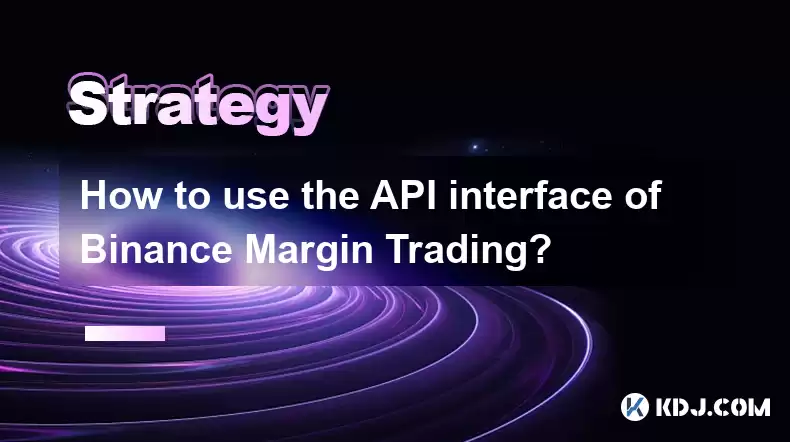-
 bitcoin
bitcoin $87959.907984 USD
1.34% -
 ethereum
ethereum $2920.497338 USD
3.04% -
 tether
tether $0.999775 USD
0.00% -
 xrp
xrp $2.237324 USD
8.12% -
 bnb
bnb $860.243768 USD
0.90% -
 solana
solana $138.089498 USD
5.43% -
 usd-coin
usd-coin $0.999807 USD
0.01% -
 tron
tron $0.272801 USD
-1.53% -
 dogecoin
dogecoin $0.150904 USD
2.96% -
 cardano
cardano $0.421635 USD
1.97% -
 hyperliquid
hyperliquid $32.152445 USD
2.23% -
 bitcoin-cash
bitcoin-cash $533.301069 USD
-1.94% -
 chainlink
chainlink $12.953417 USD
2.68% -
 unus-sed-leo
unus-sed-leo $9.535951 USD
0.73% -
 zcash
zcash $521.483386 USD
-2.87%
How to use the API interface of Binance Margin Trading?
To use Binance Margin Trading API, set up credentials, connect via HTTPS, and manage accounts, loans, orders, and positions programmatically.
Apr 11, 2025 at 01:21 am

How to use the API interface of Binance Margin Trading?
Binance Margin Trading offers users the ability to trade with borrowed funds, amplifying potential returns (and risks). To interact with these features programmatically, Binance provides an API interface that allows developers to automate trading, manage positions, and analyze data. This guide will walk you through the steps and considerations for using the Binance Margin Trading API.
Understanding the Binance Margin Trading API
Before diving into the specifics of using the API, it's important to understand what the Binance Margin Trading API offers. This API allows you to perform actions such as creating and managing margin accounts, borrowing assets, placing margin orders, and repaying loans. The API endpoints are designed to interact with the margin trading system, and they require specific permissions to operate.
Setting Up Your API Credentials
To use the Binance Margin Trading API, you need to set up your API credentials. Here's how you can do it:
- Log in to your Binance account and navigate to the API Management section.
- Create a new API key. Make sure to enable the necessary permissions for margin trading, including 'Enable Margin Trading' and 'Enable Futures'.
- Save your API key and secret key securely. These keys are crucial for authenticating your API requests.
Connecting to the API
Once you have your API credentials, you can start making requests to the Binance Margin Trading API. Here's how to connect:
- Choose your programming language and use a library that supports HTTP requests and HMAC-SHA256 signing, such as Python's
requestsandhmaclibraries. - Set up your API endpoint URL. For example, the base URL for Binance's API is
https://api.binance.com. - Create a function to sign your requests. This involves using your secret key to generate a signature for each request.
Here's a basic example in Python:
import requestsimport hmacimport timeimport hashlib
api_key = 'YOUR_API_KEY'api_secret = 'YOUR_SECRET_KEY'
def sign_request(params):
query_string = '&'.join([f'{key}={params[key]}' for key in sorted(params)])
signature = hmac.new(api_secret.encode('utf-8'), query_string.encode('utf-8'), hashlib.sha256).hexdigest()
return signature
def make_request(endpoint, params):
params['timestamp'] = int(time.time() * 1000)
params['signature'] = sign_request(params)
headers = {'X-MBX-APIKEY': api_key}
response = requests.post(f'https://api.binance.com{endpoint}', headers=headers, data=params)
return response.json()
Managing Margin Accounts
With the API connection established, you can now manage your margin accounts. Here are some key operations:
- Create a Margin Account: Use the
/sapi/v1/margin/create endpoint to create a new margin account. You need to specify the asset and amount you want to transfer to the margin account.
params = {
'asset': 'BTC',
'amount': '0.1'
}response = make_request('/sapi/v1/margin/create', params)
- Transfer Funds: Use the
/sapi/v1/margin/transferendpoint to move funds between your spot and margin accounts. Specify theasset,amount, andtype(1 for spot to margin, 2 for margin to spot).
params = {
'asset': 'BTC',
'amount': '0.1',
'type': '1'
}response = make_request('/sapi/v1/margin/transfer', params)
- Get Margin Account Details: Use the
/sapi/v1/margin/accountendpoint to retrieve information about your margin account, including balances and positions.
params = {}response = make_request('/sapi/v1/margin/account', params)Borrowing and Repaying Assets
A crucial aspect of margin trading is borrowing assets to increase your trading power. Here's how to manage borrowing and repayment:
- Borrow Assets: Use the
/sapi/v1/margin/loanendpoint to borrow assets. Specify theassetandamountyou want to borrow.
params = {
'asset': 'USDT',
'amount': '1000'
}response = make_request('/sapi/v1/margin/loan', params)
- Repay Loans: Use the
/sapi/v1/margin/repayendpoint to repay borrowed assets. Specify theasset,amount, andisolatedSymbolif applicable.
params = {
'asset': 'USDT',
'amount': '1000'
}response = make_request('/sapi/v1/margin/repay', params)
Placing Margin Orders
To trade on margin, you need to place margin orders. Here's how to do it:
- Place a Margin Order: Use the
/sapi/v1/margin/orderendpoint to place a margin order. Specify thesymbol,side(BUY or SELL),type(LIMIT, MARKET, etc.), and other parameters as needed.
params = {
'symbol': 'BTCUSDT',
'side': 'BUY',
'type': 'LIMIT',
'quantity': '0.1',
'price': '20000'
}response = make_request('/sapi/v1/margin/order', params)
- Get Order Details: Use the
/sapi/v1/margin/orderendpoint with theorderIdparameter to retrieve details about a specific order.
params = {
'symbol': 'BTCUSDT',
'orderId': '123456789'
}response = make_request('/sapi/v1/margin/order', params)
Managing Margin Positions
Managing your margin positions is crucial for effective trading. Here's how to do it:
- Get Margin Position Details: Use the
/sapi/v1/margin/positionRiskendpoint to get details about your current margin positions.
params = {}response = make_request('/sapi/v1/margin/positionRisk', params)- Close a Margin Position: To close a margin position, you can place an order to sell (if long) or buy (if short) the asset. Use the
/sapi/v1/margin/orderendpoint as described above.
Handling Errors and Rate Limits
When using the Binance Margin Trading API, it's important to handle errors and respect rate limits:
- Error Handling: Always check the response for errors. Binance returns error codes and messages in the response JSON. For example:
if 'code' in response and response['code'] != 200:
print(f'Error: {response['msg']}')
- Rate Limits: Binance has strict rate limits on API requests. Monitor your request frequency and use the
/sapi/v1/account endpoint to check your current rate limit status.
params = {}
response = make_request('/sapi/v1/account', params)print(f'Rate Limit Status: {response['rateLimits']}')
Frequently Asked Questions
Q: Can I use the same API key for both spot and margin trading on Binance?A: Yes, you can use the same API key for both spot and margin trading, but you need to ensure that the necessary permissions are enabled for margin trading in the API Management section of your Binance account.
Q: What happens if I exceed the rate limits on the Binance Margin Trading API?A: If you exceed the rate limits, your API requests will be rejected, and you will receive an error response. It's important to monitor your request frequency and implement proper error handling and retry mechanisms.
Q: Is it possible to automate margin trading strategies using the Binance Margin Trading API?A: Yes, you can automate margin trading strategies using the Binance Margin Trading API. By writing scripts that interact with the API, you can automate tasks such as placing orders, managing positions, and executing trading strategies based on predefined rules or market conditions.
Q: How can I ensure the security of my API keys when using the Binance Margin Trading API?A: To ensure the security of your API keys, never share them with anyone, store them securely (preferably in environment variables or a secure vault), and use them only on trusted devices. Additionally, regularly monitor your API key usage and immediately revoke any compromised keys.
Disclaimer:info@kdj.com
The information provided is not trading advice. kdj.com does not assume any responsibility for any investments made based on the information provided in this article. Cryptocurrencies are highly volatile and it is highly recommended that you invest with caution after thorough research!
If you believe that the content used on this website infringes your copyright, please contact us immediately (info@kdj.com) and we will delete it promptly.
- Sleep Token's 'Caramel' Crowned Best Song of 2025 by The New York Times, Igniting Fan Frenzy
- 2025-12-09 22:25:01
- Dropee's Listing Delay: A Deep Dive into Its Booming Ecosystem and Evolving Launch Plan
- 2025-12-09 22:25:01
- Coin Toss on Discord Call Seals Fate of Highly Anticipated Indie Game Sequel, Slay the Spire 2
- 2025-12-09 22:10:02
- Eden Miner Pioneers AI-Driven Stable Crypto Yields: A Game Changer for Savvy Investors
- 2025-12-09 22:10:02
- ONDO Ignites: SEC Probe Closes, Paving Way for Major Price Push and RWA Dominance
- 2025-12-09 22:00:02
- XRP Poised to Dominate Fintech Coin Landscape by 2027, Analysts Predict
- 2025-12-09 22:00:01
Related knowledge

Why My "Gut Feeling" About Crypto Is Always Wrong.
Dec 07,2025 at 07:00am
Emotional Triggers in Market Participation1. Fear of missing out (FOMO) drives impulsive buys during sharp price surges, often right before a correcti...

How to Build a Crypto Strategy That Works Even When You're Wrong.
Dec 07,2025 at 10:19am
Understanding Market Cycles1. Cryptocurrency markets operate in distinct phases: accumulation, markup, distribution, and markdown. These phases repeat...

How to Stop Treating Crypto Like a Casino and Start Building Wealth.
Dec 08,2025 at 02:00am
Understanding the Fundamentals1. Cryptocurrencies are not just speculative instruments—they represent protocols, networks, and economic systems with m...

The Fear of Missing Out (FOMO) vs. The Fear of Losing Everything (FUD): Which Is Worse?
Dec 09,2025 at 11:40am
FOMO in Cryptocurrency Markets1. FOMO emerges when traders observe rapid price surges in assets like Bitcoin or meme coins without participating in th...

"I Should Have Bought More": How to Deal with Post-Pump Regret.
Dec 07,2025 at 04:19pm
Understanding the Psychology Behind FOMO1. The human brain processes gains and losses asymmetrically, assigning greater emotional weight to missed opp...

My Friend Got Rich on a Shitcoin, Why Can't I? The Psychology of Gambling vs. Investing.
Dec 07,2025 at 01:39pm
The Illusion of Control in Volatile Markets1. Traders often misattribute random outcomes to skill, especially after witnessing a friend’s sudden gain ...

Why My "Gut Feeling" About Crypto Is Always Wrong.
Dec 07,2025 at 07:00am
Emotional Triggers in Market Participation1. Fear of missing out (FOMO) drives impulsive buys during sharp price surges, often right before a correcti...

How to Build a Crypto Strategy That Works Even When You're Wrong.
Dec 07,2025 at 10:19am
Understanding Market Cycles1. Cryptocurrency markets operate in distinct phases: accumulation, markup, distribution, and markdown. These phases repeat...

How to Stop Treating Crypto Like a Casino and Start Building Wealth.
Dec 08,2025 at 02:00am
Understanding the Fundamentals1. Cryptocurrencies are not just speculative instruments—they represent protocols, networks, and economic systems with m...

The Fear of Missing Out (FOMO) vs. The Fear of Losing Everything (FUD): Which Is Worse?
Dec 09,2025 at 11:40am
FOMO in Cryptocurrency Markets1. FOMO emerges when traders observe rapid price surges in assets like Bitcoin or meme coins without participating in th...

"I Should Have Bought More": How to Deal with Post-Pump Regret.
Dec 07,2025 at 04:19pm
Understanding the Psychology Behind FOMO1. The human brain processes gains and losses asymmetrically, assigning greater emotional weight to missed opp...

My Friend Got Rich on a Shitcoin, Why Can't I? The Psychology of Gambling vs. Investing.
Dec 07,2025 at 01:39pm
The Illusion of Control in Volatile Markets1. Traders often misattribute random outcomes to skill, especially after witnessing a friend’s sudden gain ...
See all articles










































































